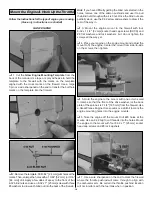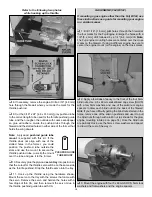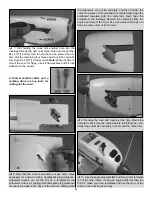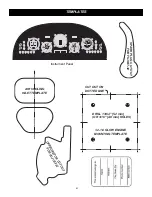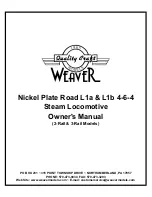
3
.5 Proof of Flight: The completing and signing of the
Declaration section of the Safety Inspection form by the
pilot (or owner) shall document as fact that each aircraft
has been successfully flight-tested and proven airworthy
prior to an IMAA event.
Section 5.0: EMERGENCY ENGINE SHUT OFF
(Kill Switch)
5.1 All magneto spark ignition engines must have a coil
grounding switch on the aircraft to stop the engine. This
will also prevent accidental starting of the engine. This
switch shall be readily available to both pilot and helper.
This switch is to be operated manually and without the
use of the radio system.
5.2 Engines with battery power ignition systems must have a
switch to turn off the power from the battery pack to disable
the engine from firing. This will also prevent accidental
starting of the engine. This switch shall be readily available
to both pilot and helper. This switch shall be operated
manually and without the use of the Radio System.
5.
3
There must also be a means to stop the engine from the
transmitter. The most common method is to close the
carburetor throat completely using throttle trim, however,
other methods are acceptable. This requirement applies
to all glow/gas ignition engines regardless of size.
Section 6.0: RADIO REQUIREMENTS
6.1 All transmitters must be FCC type certified.
6.2 FCC Technician or higher-class license required for 6
meter band operation only.
ADDITIONAL IMAA GENERAL RECOMMENDATIONS
The following recommendations are included in the Safety
Code not to police such items, but rather to offer basic
suggestions for enhanced safety.
• Servos need to be of a rating capable to handle the loads that
the control surfaces impose upon the servos. Standard
servos are not recommended for control surfaces. Servos
should be rated heavy-duty. For flight-critical control functions
a minimum of 45 inch/ounces of torque should be
considered. This should be considered a minimum for smaller
aircraft and higher torque servos are strongly encouraged for
larger aircraft. The use of one servo for each aileron and one
for each elevator half is strongly recommended. Use of dual
servos is also recommended for larger aircraft.
• On-board batteries shall be 1000 mAh up to 20 lbs., 1200
mAh to 30 lbs., 1800 mAh to 40 lbs. and 2000 mAh over 40
lbs. flying weight. The number and size of servos, size and
loads on control surfaces, and added features should be
considered as an increase to these minimums. Batteries
should be able to sustain power to the onboard radio
components for a minimum of one hour total flying time
before recharging.
• Redundant and fail-safe battery systems are recommended.
• The use of anti-glitch devices for long leads are recommended.
• There is no maximum engine displacement limit, as it is the
position of this body that an underpowered aircraft
presents a greater danger than an overpowered aircraft.
However, the selection of engine size relative to airframe
strength and power loading mandates good discretionary
judgment by the designer and builder. Current AMA
maximums for engine displacement are 6.0 cu. in. for two-
stroke and 9.6 cu. in. for four-stroke engines. These
maximums apply only to AMA Sanctions concerning
competition events (such as 511, 512, 515 and 520) and,
as such, the maximums apply. All IMAA (non competition)
events should be sanctioned as Class “C” events, in which
these engine size maximums do not apply.
• Generally, it is recommended that no attempt should be
made to fly a radio controlled model aircraft with a gasoline
engine in which the model aircraft weight would exceed
twelve (12) pounds (underpowered) per cubic inch of
engine displacement, or be less than five (5) pounds
(overpowered) per cubic inch of engine displacement.
Example: Using a 3 cu. in. engine, a model would likely be
underpowered at an aircraft weight greater than 36
pounds. With the same engine, an aircraft weighing less
than 15 pounds would likely be overpowered.
• Servo arms and wheels should be rated heavy duty. Glass-
filled servo arms and control horns are highly recommended.
• Control surface linkages are listed in order of preference:
1. Cable system (pull-pull). A tiller bar is highly
recommended along with necessary bracing.
2. Arrow-shaft, fiberglass or aluminum, 1/4" or 5/16" OD.
Bracing every six (6) to ten (10) inches is highly
recommended.
3. Tube-in-tube (Nyrod). Bracing every few inches is
highly recommended. Inner tube should be totally
enclosed in outer tube.
4. Hardwood dowel, 3/8" OD. Bracing every six (6) to ten
(10) inches is highly recommended.
• Hinges should be rated heavy duty and manufactured for
Giant Scale use primarily. Homemade and original design
hinges are acceptable if determined to be adequate for the
intended use.
• Clevis (steel, excluding heavy-duty ball links) and
attachment hardware should be heavy duty 4-40 threaded
rod type. 2-56 threaded size rod is acceptable for some
applications (e.g. throttle). Clevis is to have lock nuts and
sleeve or spring keepers.
• Propeller tips should be painted or colored in a visible and
contrasting manner so as to increase the visibility of the
propeller tip arc.
2
8
Содержание Giant Super Sportster
Страница 32: ......

